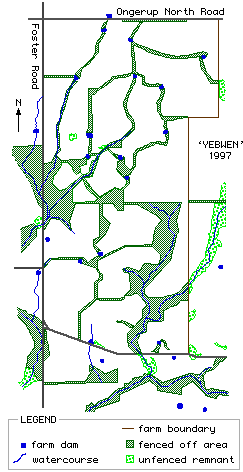
Stephen Newbey, Foster Road, Ongerup

|
Cleveland Creek protection and restoration
Stephen Newbey, Foster Road, Ongerup |
 |
 Background
Background
The northwest Ongerup area was opened up for agriculture in 1911 and the Newbey family bought the 1080 hectare property "Yebwen" in 1938. Clearing and land development took place from then up until 1962. Steve started working on the farm in 1978 and took over its management in 1988. Cleveland Creek is the local name of the small network of tributaries which runs through Steve's property. Jakeal's Creek runs down the eastern side of the farm into the Ongerup Creek then the Warperup Creek, which eventually joins the Pallinup River to the southwest. The top portion of the creek catchment is in a neighbour's farm to the north. The riparian zone originally comprised an open woodland of salmon gum and yate, samphire floodplain, swamp mallet, mallee and paperbark species in the lowest part of the creek. Jakeal's Creek catchment is between 90% to 95% cleared of native vegetation and there are no large remnants. Since 1988 Steve has created 29 kilometres of revegetated corridors across the property and has incorporated most of his dams into the network. Thousands of trees have been planted and the network is linked to adjoining corridors and road reserves and now forms part of a major wildlife corridor between an important malleefowl breeding area on Foster Road to the north and Warperup Creek to the south. Steve has also played a big part in getting the entire Warperup Creek fenced from Ongerup to the Pallinup River. The property is now registered under the Land for Wildlife scheme with the Department of Conservation and Land Management. The Problem When he first took over management of the farm Steve saw the major management issues as:
The restoration of Jakeal's Creek was part of the plan as it had been grazed ever since the surrounding land was cleared in the late 1940s and was quite bare of vegetation prior to fencing in 1994. The problem was exacerbated by the sheep congregating on the bare areas, which were then susceptible to wind erosion. The water was fresh when Steve fenced the creek off and because of that he planted Eucalyptus megacornuta in the riparian zone. Steve has noticed that the salt has moved upstream over the past 10 years and has killed some of the trees. The creek is now severely silted up from runoff from the mainly cleared catchment.
To help to address the issues of erosion and lack of shelter belts, Jakeal's Creek was fenced during 1994 and planted with local native species in 1996. About six kilometres of fencing was installed along with thousands of trees. Prior to planting the area was shallow ripped to prevent any underlying clay clods being brought to the surface. The revegetation was carried out using a Chatfield Tree Planter, which scalps the area removing weeds and stored seeds. Four rows of seedlings were planted at a spacing of 5 metres and a row space of 6 metres. At the same time the area was direct seeded using a seed box on the back of the planter. The following year the area between each row was direct seeded, giving eight rows in total. Steve collects local seed for direct seeding as much as possible, with as many different shrub and understorey species as he can collect. He has achieved a survival rate of about 70% with his planted seedlings. Steve uses only shrubs and other understorey species in the revegetation as he has found that trees tend to grow too quickly and they shade out the understorey as well as competing for water and nutrients. He has also found that the overstorey regenerates naturally given time. A small number of trees are hand-planted where shade is required in a shorter time and Steve carries this out on an ongoing basis as time permits. Some healthy original vegetation remained in the corridor and some natural regeneration took place soon after fencing. Steve has noticed that the pigface has all regenerated despite being trampled by sheep for over 40 years. A trial of wavy-leaf saltbush was put in on a bare salt scald during 1969-70. He has noticed that it has taken over 20 years to spread a few metres outside the trial plot. In hindsight Steve would like to have put the fence further out in some places as some of the saline areas now extend beyond the existing fence. A small tributary of Jakeal's Creek has been fenced to a width of about 20 metres but Steve believes that this is not wide enough. "The reason I did it was simply to stabilise the gully". He planted trees and direct seeded in the corridor and has noticed that Acacia saligna is now the dominant shrub. He sees this as a really good example of what happens if too much A. saligna is included in the seed mix. Steve applied for fencing funding through the Remnant Vegetation Protection Scheme but this was unsuccessful and so he has paid for all the work on Jakeal's Creek himself. A total of 60 hectares of the creek is now fenced off. In the future Steve would like to try and control weeds around the small granite outcrops in the riparian zone. He would also like to convert areas of bare salt within the Jakeal's Creek system to wetlands by diverting some surface water into them as well as retaining the water in the creek. He says that they would then become effective evaporation ponds and valuable wetlands for fauna.
Where Jakeal's Creek leaves the property the Gnowangerup Shire built the road up and installed a box culvert. Two years later it was washed away in a flood and in the interim a lot of sand built up behind it on Steve's property. The creek is now in the process of re-establishing the old creek bed and as a consequence sand is being washed downstream giving the appearance of an erosion problem. Steve has elected to do nothing at this stage and allow the creek to form its own path. To address the lack of dams Steve decided not only to build more dams, but also to plan them so that siltation sedimentation was minimised (therefore reducing management costs) and wildlife habitat was created. Steve is a Community Landcare Technician so he has been able to survey all his own dams. Since 1989 ten dams have been added to the property and these have been sited to reduce evaporation. "I try to get shelter belts to be near dams to keep the wind off the surface of the dam. Ideally you would have bush all around a dam but you've got to have access for stock somewhere so you have to put up with wind from one direction". The shelterbelts also filter the water for the dams. "....I quite happily fence them off because you get a summer thunderstorm and you don't get your dam full of sheep manure and soil".
In an innovative project Steve has constructed shelters for waterbirds in the overflow areas of some of his dams. These structures have been built using old jam fence posts and they are in a variety of shapes such as a wigwam, fort, BBQ and a wall. They act as islands and the nesting ducks are able to shelter their young from birds of prey, cats and foxes. He has further increased the value of these dams for nature conservation by encouraging the recolonisation of sedges and rushes with the aim of recreating wetland sites. Suitable trees and shrubs have also been planted to enhance the habitat.
The Outcomes and Observations Steve wants to leave behind a healthier farm for future generations and felt that revegetation of the creeklines would contribute towards this goal. His planning and implementation have resulted in stable creeklines and more diverse wildlife habitat. For example, he has noticed that fat-tailed dunnarts are using the mounds between rows for shelter. "They particularly like where the tree planter scalps and tips the soil over and they get in the grassed area in the middle. It's like a Swiss roll and they live in there. They also seem to live in the samphire areas as well". He also saw, for the first time, a blue tongue skink in one of the corridors during the summer. At present Steve believes that the benefits of all the restoration works to his farming enterprise have been mainly as shelter for sheep. He has also noticed that crops and pasture grow better adjacent to shelter belts, particularly on the east side of a patch of bush. "I have put shelter belts around all my paddocks here for that very reason, because the wind comes from every direction, and the creek ones fit into that a fair bit". "You've got to take responsibility for the quality and amount of water that leaves your property. There's no excuse for exporting water that is silty or full of nutrients. Anywhere where water concentrates on this farm is fenced off. If it runs out of a contour bank down a grassed waterway it's fenced off. Anywhere where a dam overflows it's fenced off. The other thing with that too is it actually helps the water quality in the dam because you're filtering out all the rubbish here before it actually gets into the dam. So the water quality in the dam is improved for the sheep too. It's not all "green" thinking. That's what it started off with, to filter the water for the sheep and then I thought if I'm going to have this pool of water lying there that the sheep can't use any more what can I do with it? The shelterbelt of trees goes around the north side of the dam so that will protect that water from the hot northerly and northwesterly winds. On the farming side of things the shelterbelt, apart from reducing dam evaporation, is also on the south side of the paddock to provide shelter for the livestock when we get cold southerlies. I really think that if people think about it they can make conservation fit in very well with their farming". Steve has been delighted to see black ducks, wood ducks and grey teal successfully raising young on his dams and using the shelters. "A lot of birds come in to drink here so they're not just for the ducks. The other thing I've noticed is in the summer when it's hot and birds come in to the dam for a drink they'll quite often hang around in the shade around them. The plovers in particular seem to like it. Even if a hawk came along there's somewhere where they can dart into and not be seen". With the dams Steve has successfully reduced his own costs and at the same time has created wildlife habitat. He is constantly experimenting with ideas and learning as he goes about implementing his farm plan. "In the early days of planting I used to plant a couple of rows of trees. I have been filling these areas in using the tree planter recently". The revegetation work in Jakeal's has been successful and in time he hopes it will provide a buffer for the waterway. Showing his optimism for the future Steve says, "I think that in 10 years if we can continue along the way we're going, when water leaves my house here as soon as it goes down to the creek at the bottom it will go all the way from there to the sea in fenced off wetland corridors". He likens the network of dryland and wetland corridors to a cardiovascular system. "....corridors are now like your veins and arteries and the blue ones are the water ones and the red ones are the land ones. So you've got a cardiovascular system. I think that the river ones and the watercourse ones are important, like your veins are important. But they're not much good without the arteries, so you've got to try and get your arteries, which are your road verges and the other ones that you can get here and there on dry land". Where possible Steve has also tried to link with remnant vegetation on neighbouring farms. He says, "even if its not fenced off I assume in time it will get fenced off". The Jakeal's Creek corridor is quite wide in some places and Steve says, "I really think there's the ability to make [wildlife] corridors out of some of these salt creeks as long as you can tap in on these little bits and pieces that are along them. Rather than having something that's half a kilometre wide the whole distance, if you have something that might narrow down to 20-30 metres and then widens out to a couple of hundred metres, to me you still create a corridor. Just when you first start fencing those off it looks like a lot of land to fence off, but I think in 30 years that fence will come out further and in a hundred years time it will be half way up to the shearing shed; but you go in stages". Carrying on the family interest in birds Steve is monitoring them across his farm to get some idea of the success or otherwise of his restoration work for nature conservation. He has documented birds returning to the farm, some of which haven't been recorded since his teenage years. Jakeal's Creek catchment statistics
Map Reference: 1: 50 000 2530-II |
|||||||||||||||
 |
||||||||||||||||
 |
||||||||||||||||